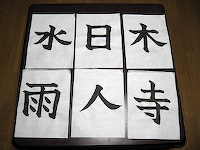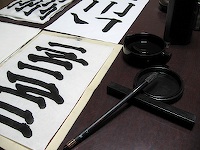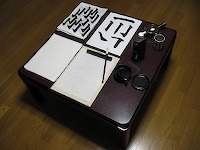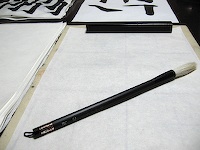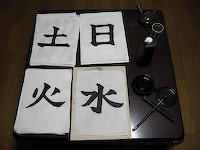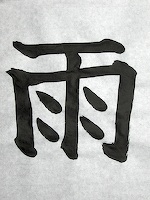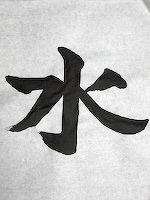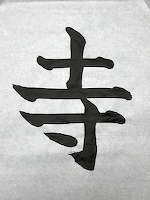
Shodō (Calligraphy)
I've been learning and practising the Japanese writing system for the past 18 months, but up until today I had never tried writing with a brush. Surely this was obvious to Setsuko Endō — my shodō teacher — when I began my first class this morning. Upon arriving at her house, she led me into the small classroom, where a few other students were already practising. She showed me how to hold the brush, and corrected my posture several times, reminding me to relax and keep my elbow up (not leaning on the table). Of course, when one tries to do something very carefully, the tendency is to tense up, so it's a little bit trickier than it sounds, to relax on purpose. It's the sort of thing one has to just do without trying, and it serves as an excellent precursor to the entire spirit of shodō.
Endō-sensei started me off with the simplest of characters, the single horizontal stroke for ichi — the number one. She had me hold the brush while she guided me the first couple times, then had me practise it on my own. It begins with a downward push of the brush, a slight turn, then the horizontal stroke from left to right, ending with a second downward push to give it a beautiful shape at both ends. She then showed me several vertical strokes with different endings — a "regular" stroke, a point, and a hook. I'll be learning many more of these strokes, which make up the components of the kanji characters. Each character presents its own challenges, and these are the building blocks I'll need, to write entire characters.At the end of the class, I told Endō-sensei that I'd like to continue practising at home. She lent me an inkwell, a piece of felt (which sits under the paper so you don't get ink all over your table), and a paperweight, and I bought a brush and some India ink from her. I've already got a big stack of rice paper at my apartment, as one of the previous English teachers was also studying with her. So I spent the afternoon practising the strokes she taught me, and eventually attempted a few real characters as well. I tried writing the characters for the days of the week, and a few other relatively simple characters such as ame (rain) and tera (temple).
There are many reasons to come to Japan. Some come for the anime, the wacky clothes, bright lights, and cool technology (and don't get me wrong, I'm here for all of that stuff too), but shodō truly embodies what really led me here — a culture with a fascination for embarking on long journeys to develop the patience and skill required to master an intricate art.

